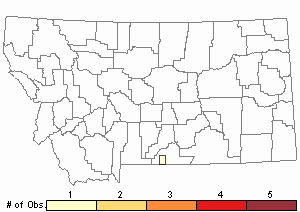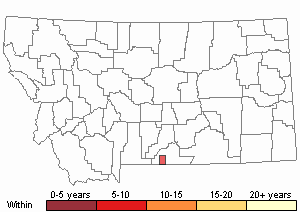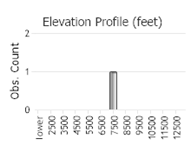View in other NatureServe Network Field Guides
NatureServe
Montana
Utah
Wyoming
Idaho
Wisconsin
British Columbia
South Carolina
Yukon
California
New York
A Diatom - Stauroneis neohyalina
General Description
Morphological Category – Symmetric biraphid
Valves linear-lanceolate with protracted and narrowly rostrate to subcapitate apices. Raphe weakly lateral, becoming filiform at the distal and proximal ends. Proximal raphe ends small and straight, not inflated. Axial Area narrow, barely wider than the raphe, flaring slightly at the stauros. Central Area a rectangular stauros, often asymmetric and slightly wider at valve margins. Striae radiate throughout. Short striae are sometimes present at the margins of the stauros. Areolae irregularly spaced and difficult to resolve in LM.
Length: 30-54 µm. Width: 6.0-9.0 µm. Striae in 10 µm: 32-40.
Diagnostic Characteristics
Stauroneis bryocola has lanceolate valves with subtly protracted and broadly rounded apices. Stauroneis gracilior, S. kootenai, and S. pikuni have lanceolate valves with capitate apices and a lower stria and areola density (less than 30 in 10 µm). Stauroneis schroederi has lanceolate valves with gradually attenuated apices and striae and areolae less than 30 in 10 µm.
Range Comments
Widely distributed in mountainous areas of North America, Europe, and Asia.
Type Locality
Central France
Number of Observations in Montana Diatom Collection Database (Bahls 1968-2019)
Total: 22. Montana: 17. NOTE: In Diatoms of Montana (Bahls 2021) see Plate 108, page 298, otherwise species was unintentionally omitted.
Observations in Montana Natural Heritage Program Database
Number of Observations: 1
(Click on the following maps and charts to see full sized version)
Map Help and Descriptions
Relative Density

Recency



 (Observations spanning multiple months or years are excluded from time charts)
(Observations spanning multiple months or years are excluded from time charts)
Habitat
Small lakes and wetlands.
Ecology
In Montana waters where S. neohyalina is found, pH ranges from 6.2 to 7.6 and specific conductance ranges from 8 to 109 µS/cm. Lange-Bertalot & Metzeltin (1996) reported this species from an electrolyte-poor, humic-rich lake in Finland. Siver et al. (2005) reported this species (as Stauroneis gracilior) from somewhat acidic ponds on Cape Cod, Massachusetts.
Reproductive Characteristics
GENERAL LIFE CYCLE
Diatoms typically reproduce by cell division (mitosis) and occasionally by meiosis—sexual reproduction in which female and male gametes combine to form a specialized zygote called an auxospore. Repeated divisions result in cells of a population becoming progressively smaller and smaller. When cells reach a critically small size, sexual reproduction is initiated, resulting in an auxospore and initial cells that are the largest attainable for the species, after which cell division and size reduction resume (Amato 2010).
Stewardship Responsibility
Threats or Limiting Factors
Climate change and regional warming is a threat to S. neohyalina.
References
- Literature Cited AboveLegend:
 View Online Publication
View Online Publication Amato, A. 2010. Diatom reproductive biology: living in a crystal cage. The International Journal of Plant Reproductive Biology 2(1): 1-10.
Amato, A. 2010. Diatom reproductive biology: living in a crystal cage. The International Journal of Plant Reproductive Biology 2(1): 1-10. Bahls, Loren. 2010. Stauroneis in the Northern Rockies: 50 species of Stauroneis sensu stricto from western Montana, northern Idaho, northeastern Washington and southwestern Alberta, including 16 species described as new. Northwest Diatoms, Volume 4. The Montana Diatom Collection, Helena, 172 pp.
Bahls, Loren. 2010. Stauroneis in the Northern Rockies: 50 species of Stauroneis sensu stricto from western Montana, northern Idaho, northeastern Washington and southwestern Alberta, including 16 species described as new. Northwest Diatoms, Volume 4. The Montana Diatom Collection, Helena, 172 pp. Bahls, Loren. 2021. Diatoms of Montana and western North America: Catalog and atlas of species in the Montana diatom collection Volume 1. The Academy of Natural Sciences of Philadelphia Special Publication 24. 508pp.
Bahls, Loren. 2021. Diatoms of Montana and western North America: Catalog and atlas of species in the Montana diatom collection Volume 1. The Academy of Natural Sciences of Philadelphia Special Publication 24. 508pp. Siver, P.A., Hamilton, P.B., Stachura-Suchoples, K. and Kociolek, J.P. 2005. Diatoms of North America. The Freshwater Flora of Cape Cod. Iconographia Diatomologica 14: 1-463.
Siver, P.A., Hamilton, P.B., Stachura-Suchoples, K. and Kociolek, J.P. 2005. Diatoms of North America. The Freshwater Flora of Cape Cod. Iconographia Diatomologica 14: 1-463.
- Additional ReferencesLegend:
 View Online Publication
View Online Publication
Do you know of a citation we're missing? Lange-Bertalot, H. and Metzeltin, D. 1996. Indicators of oligotrophy - 800 taxa representative of three ecologically distinct lake types, carbonate buffered - oligodystrophic - weakly buffered soft water. Lange-Bertalot, H. (ed.), Iconographia Diatomologica. Annotated Diatom Micrographs. Vol. 2. Ecology, Diversity, Taxonomy. Koeltz Scientific Books. Königstein, Germany, 390 pp.
Lange-Bertalot, H. and Metzeltin, D. 1996. Indicators of oligotrophy - 800 taxa representative of three ecologically distinct lake types, carbonate buffered - oligodystrophic - weakly buffered soft water. Lange-Bertalot, H. (ed.), Iconographia Diatomologica. Annotated Diatom Micrographs. Vol. 2. Ecology, Diversity, Taxonomy. Koeltz Scientific Books. Königstein, Germany, 390 pp.
- Web Search Engines for Articles on "A Diatom"





